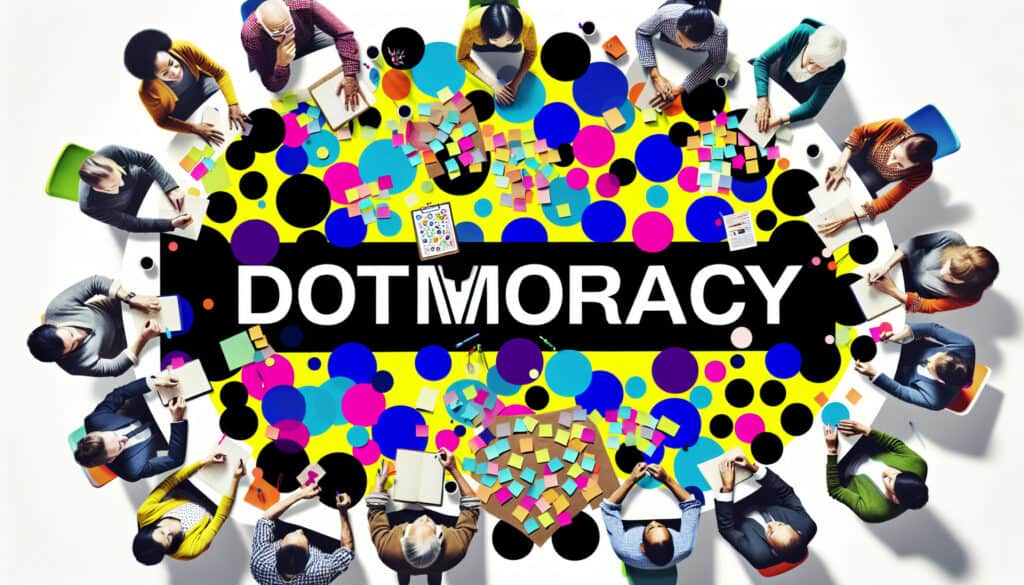A simple facilitation metodo used to help a large group of people prioritize a list of options democratically and visually.
- Metodologie: Clienti e marketing, Economia, Progettazione del prodotto
Dotmocracy

Dotmocracy
- Metodologia agile, Miglioramento continuo, Pensiero progettuale, Ideazione, Innovazione, Gestione del progetto, Lavoro di squadra, Progettazione incentrata sull'utente
Obiettivo:
Come si usa:
- After a list of ideas is generated and posted on a wall, each participant is given a small number of stickers (dots). They then place their dots on the options they prefer, allowing the group to quickly see which ideas have the most support.
Professionisti
- Is a very simple, fast, and transparent way to gauge group consensus; is highly democratic and encourages equal participation; provides a clear visual summary of priorities.
Contro
- Can lead to 'groupthink' where people are influenced by where others have placed their dots; does not allow for discussion or nuance about why an option is preferred.
Categorie:
- Ideazione, Risoluzione dei problemi, Gestione del progetto
Ideale per:
- Quickly and democratically prioritizing a list of ideas in a group setting using stickers or dots.
Dotmocracy is particularly beneficial in environments where collaborative decision-making is fundamental, such as in design thinking workshops, community engagement projects, and corporate brainstorming sessions. Industries such as product development, urban planning, and educational program design frequently utilize this methodology, especially in the conceptual phases where diverse viewpoints are essential to inform the direction of a project. Participants in a Dotmocracy session may include designers, engineers, project stakeholders, and end-users, allowing for a rich cross-section of opinions that can enhance the idea generation process. This method is adaptable across various contexts, from initial idea generation phases to concluding evaluations of proposed solutions, providing a clear framework for collective prioritization. The visual representation of dots on ideas creates an immediate understanding of consensus within the group, making it easy to identify which concepts resonate most strongly with participants. This rapid form of evaluation not only speeds up decision-making but also increases engagement, as everyone has an equal opportunity to weigh in on the options presented. It is particularly useful in settings where time is limited and quick feedback loops are required, allowing teams to pivot based on collective preferences without extensive debates or prolonged discussions. Using tools like sticky notes or digital platforms that simulate this process, organizations can maintain transparency and inclusiveness while ensuring that all voices are heard in the early stages of product design and development.
Fasi chiave di questa metodologia
- Present the list of generated ideas for all participants to see.
- Distribute a limited number of stickers or dots to each participant.
- Allow participants to place their dots on the ideas they prefer.
- Identify the ideas with the highest number of dots as the most supported.
- Discuss the top ideas based on the dot placement for further exploration.
Suggerimenti per i professionisti
- Encourage participants to cluster similar ideas before dot voting, enhancing clarity and reducing redundancy in the options presented.
- Limit the number of dots per participant to avoid skewed results from dominant voices; this fosters more balanced input across the group.
- After voting, facilitate a brief discussion to understand the reasoning behind selections, which can uncover deeper insights into group priorities.
Leggere e confrontare diverse metodologie, raccomandiamo il
> Ampio archivio di metodologie <
insieme ad altre 400 metodologie.
I vostri commenti su questa metodologia o ulteriori informazioni sono benvenuti su sezione commenti qui sotto ↓ , così come tutte le idee o i link relativi all'ingegneria.
Contesto storico
1960
1980
1983
1990
1995
2000
2010
1950
1980
1980
1986
1994
1995
2000
(se la data non è nota o non è rilevante, ad esempio "meccanica dei fluidi", viene fornita una stima approssimativa della sua notevole comparsa)














Post correlati
Questionari sul disagio muscoloscheletrico
Test multivariati (MVT)
Analisi di regressione multipla
Sistemi di cattura del movimento
Metodo MoSCoW
Test mediano dell'umore